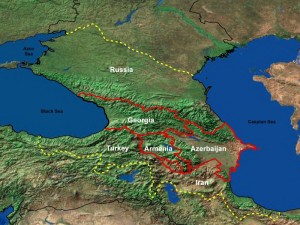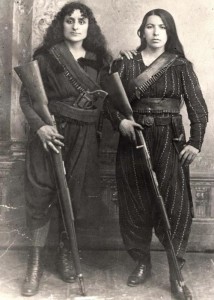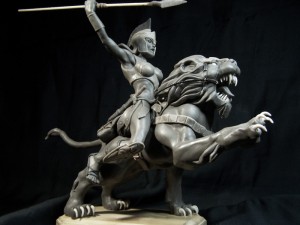John Chardin
Caucasus Mountains
The Caucasus Mountains lie between the Black and Caspian Seas and contain the highest mountain in Europe, Mount Elbrus (Russia). In ancient times it was the location of several kingdoms of whom two were known as Albania and Iberia.(d)>Today, they contain a small part of the Russia Federation along with the former Soviet republics of Armenia, Azerbaijan and Georgia.<
mountain in Europe, Mount Elbrus (Russia). In ancient times it was the location of several kingdoms of whom two were known as Albania and Iberia.(d)>Today, they contain a small part of the Russia Federation along with the former Soviet republics of Armenia, Azerbaijan and Georgia.<
>Delisle de Sales was probably the first to suggest the Caucasus as the home of the original Atlantis, with refugees from there establishing Plato’s Atlantis in the Central Mediterranean. However, the greatest proponent of the Caucasus location for Atlantis was R.A. Fessenden who wrote, The Deluged Civilisation of the Caucasus Isthmus, an extensive multi-volume work [1012] on the subject published early in the 20th century.<
>Regarding the Pillars of Herakles being in the Caucasus Fessenden noted “The fact that Nebuchadnezzar, after reaching them in his northern expedition, next went to the north shore of the Black Sea and to Thrace; and that Hercules, coming back from the pillars with the cattle of Geryon, traversed the north shore of the Black Sea (see Megasthenes, quoted by Strabo and Herodotus, 4.8), puzzled the ancient geographers because they thought that the Pillars were at the straits of Gibraltar. And because they had overlooked the fact that the Phoenicians of Sidon had known that the Pillars had been lost and that the Phoenicians had sent out four expeditions to look for them but had reached no conclusion from these expeditions except that the straits of Gibraltar were not the true Pillars of Hercules.” See Strabo, 2.5 (m)<
More recently, Ronnie Gallagher, an admirer of Fessenden, has studied the Caucasus region, in particular,  the hydrology of the Caspian Sea(a), where he identified strandlines up to 225 metres above sea level (ASL), which he considers to be evidence of a vast inland Eurasian sea at the end of the last Ice Age. In Azerbaijan, he also found cart ruts similar to those on Malta as well as stone circles on the Absheron Peninsula(b). Professor E. N. Badyukova has offered some critical comments regarding Gallagher’s claims(k).
the hydrology of the Caspian Sea(a), where he identified strandlines up to 225 metres above sea level (ASL), which he considers to be evidence of a vast inland Eurasian sea at the end of the last Ice Age. In Azerbaijan, he also found cart ruts similar to those on Malta as well as stone circles on the Absheron Peninsula(b). Professor E. N. Badyukova has offered some critical comments regarding Gallagher’s claims(k).
Flinders Petrie also referenced Fessenden in his (1926) paper The Origins of the Book of the Dead(f), in which he concluded “that the cultural connections of the earliest Egyptians, as well as the physical descriptions in their mythology, point to the Caucasus region. When, further, we find there the names of the principal places of the mythology in their relative positions, it gives strong grounds for regarding that region as the homeland of the earliest civilisation of the Egyptians.”
A few years later, an article by Margaret A. Murray in Antiquity (Volume 15 – Issue 60 – Dec. 1941) noted that Petrie’s “opinion was based entirely on literary and philological evidence” resulting in archaeologists being slow to accept it. To partially counter this Murray offered two pieces of evidence in support of Petrie’s proposed Egyptian-Caucasus connection.(i)
However, I must point out that in 1874 Hyde Clarke delivered a paper to the Royal Anthropological Institute in which he claimed that the Colchians in the Caucasus had been an Egyptian colony(h). Clarke also employed language similarities>and Herodotus’ Histories (Bk2.102-106)< to support his contention. So we can reasonably ask, who was right or were both Clarke and Flinders Petrie wrong?
A forum on Graham Hancock’s website offered some more discussion about an Egyptian link with the Caucasus(j).
Jean-Michel Hermans has claimed that the megalith builders of Brittany originally came from the Caucasus, and arrived there after a stop in what is now Bulgaria around 5000 BC(l),>and while there, they discovered mathematical relationships such as ‘pi’ and the ‘golden ratio’ !<
The Amazons of Greek mythology are thought by some to have originated in the Caucasus and as late as 1671, Sir John Chardin reported that a tribe of Amazons existed in Georgia. Interestingly, a 19th-century photo shows two armed ladies from Armenia captioned as ‘Amazons of Armenia 1895’.
An added mystery was offered by Alexander Braghine, who recounted that “I was present when a former Russian officer of Georgian origin found himself able to talk with the natives of Vizcaya immediately upon his arrival in Northern Spain: he spoke Georgian, but the Basques understood this language.” [156.187]
Currently, Bruce Fenton has claimed the Caucasus as the home of giants. However, Jason Colavito has demonstrated the unreliability of his claims(c).
In the Krasnodar region of southern Russia hundreds (actually 3,000 and counting) of dolmens are to be found on both sides of the Caucasus. Interestingly, they show a distinctive form of megalithic architecture(g).
I feel that the Caucasus will have a lot more to tell us.
(a) Wayback Machine (archive.org)
(b) https://www.azer.com/aiweb/categories/magazine/ai103_folder/103_articles/103_cart_ruts.html
(d) https://en.wikipedia.org/wiki/Caucasian_Albania
(f) Archive 6947 | (atlantipedia.ie)
(g) The mysterious dolmens and megaliths of the Caucasus – The Tapestry of Time (larazzodeltempo.it)
(h) https://www.jstor.org/stable/pdf/2841305.pdf
(i) Antiquity, Vol. 15, Issue 60, Dec. 1941 p.384-386
(j) New article: Observations on Late Pleistocene Flooding of the… – Graham Hancock Official Website
(k) Archive 7221 | (atlantipedia.ie)
(l) Amazon.fr
Amazons
Amazons is the name used by classical writers(k) to identify two matriarchal nations living near the Black Sea and in ancient Libya, but at apparently  different periods. An extensive website on the subject associates the Amazons with three locations; Lake Tritonis(j) , the Greek island of Lemnos(i) and the River Thermodon, now known as Terme Çay, in northern Turkey(h).
different periods. An extensive website on the subject associates the Amazons with three locations; Lake Tritonis(j) , the Greek island of Lemnos(i) and the River Thermodon, now known as Terme Çay, in northern Turkey(h).
Accounts relating to these remote times are understandably vague but one tale describes the Libyan Amazons as waging war against the Atlanteans, a race who lived in a prosperous country with great cities.
Attention has been drawn to the fact that the Berbers, also known as Amazigh in North-West Africa have a matriarchal culture. The possibility of an etymological connection between Amazon and Amazigh was suggested by Guy C. Rothery (1863-1940) in his 1910 book, The Amazons[1393] , and recently endorsed by Emmet Sweeney in his Atlantis: The Evidence of Science[700]. In 1912, Florence Mary Bennett published Religious Cults Associated with the Amazons[1548], which has been republished in recent years.
Another matriarchal society in the same region has also been suggested for the Maltese Islands(h).
Sir John Chardin (1643-1713) a French-born traveller and merchant reported that a tribe of Amazons still existed in the Caucasus in the 17th century(d).
Although the idea may be seen as fanciful, recent archaeological discoveries have provided evidence of female warriors in ancient times in parts of the former Soviet Union. The archaeologist Jeannine Davis-Kimball has written of her investigations[045] into the subject. Peter James offers[046] a solution to the existence of two locations for the Amazons. He believes that the original Black Sea location is correct and that the transference of the story to North Africa was the result of the ‘libyanising’ intent of Dionysus of Miletus, who was later quoted by Diodorus Siculus in his account(f) of the Amazons.
. James offers this explanation as part of a larger relocation of mythologies to more westerly locations. Other interesting views of the Amazon mystery can be found on a number of websites(a)(b).
Lewis Spence advanced the imaginative view [259.49] that the Amazons were not women at all, but men whose appearance was considered effeminate by some commentators. A more rational explanation on offer is that the males of some peoples had little facial hair or shaved (such as the Hittites) and were possibly described by their more hirsute enemies as ‘women’.
The popular idea that the Amazons were single-breasted, man-hating warriors has recently been comprehensively debunked by Adrienne Mayor in her latest book, The Amazons[1043] .
>Even more eyebrow-raising is the suggestion that Amazon warriors existed in South America based on 16th century reports and modern research(c). Columbus, in a 1493 letter to Luis de Sant’angel, refers to an island named Matininó, which was inhabited only by women(m), armed with bows and arrows. Hernán Cortés also filed a similar report.<
The Smithsonian magazine published a useful overview(e) of the history of the Amazon story in the April 2004 edition and in September 2011 revealed the story of the little-known female warriors of Benin (formerly Dahomey), numbered in their thousands, who were active during the 17th, 18th and 19th centuries. The BBC published an article in August 2018 on their history and their modern day descendants(l) .
(a) https://www.maicar.com/GML/AMAZONS.html
(b) https://web.archive.org/web/20190509212918/https://www.amazonation.com/Archaeology.html
(c) https://brazilweirdnews.blogspot.ie/2011/05/amazons-phoenicians-and-atlantis.html
(d) https://www.abebooks.com/Travels-Sir-John-Chardin-Persia-East/5455430940/bd
(e) https://www.smithsonianmag.com/history/amazon-women-there-any-truth-behind-myth-180950188/?no-ist
(f) https://archive.org/details/lp0048_amazons_vs_at
(g) https://www.smithsonianmag.com/history/dahomeys-women-warriors-88286072/?no-ist
(h) https://www.myrine.at/Amazons/mobilIndex.html
(i) https://www.myrine.at/Lemnos/mobilLemnos.html
(j) https://www.myrine.at/Berber/mobilBerber.html
(k) https://www.myrine.at/Amazons/texts_e.html
(l) https://www.bbc.com/travel/story/20180826-the-legend-of-benins-fearless-female-warriors
>(m) https://tanlistwa.com/2018/02/22/martinica-women-island-iguanas-island-or-flowers-island/<
